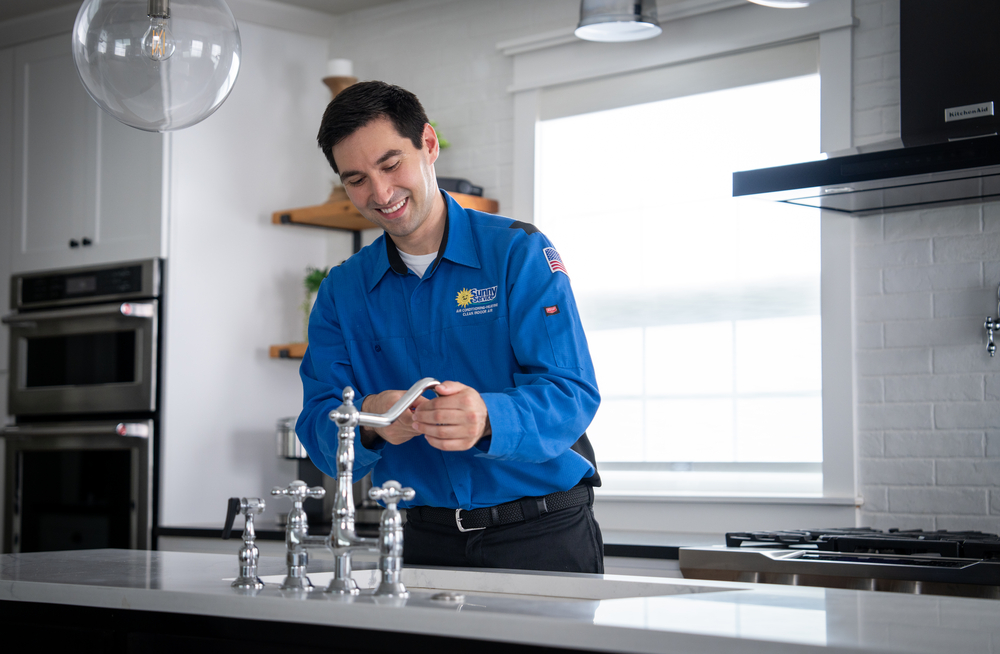You may not think about the water pressure in your home until it suddenly drops. Whether you’re rinsing dishes, taking a shower, or running the washing machine, consistent water pressure is essential for daily comfort and convenience.
When low water pressure hits, it can slow everything down. Poor pressure often signals an issue within your plumbing system that shouldn’t be ignored.
At Sunny Service, we’re proud to help homeowners in Fort Worth get to the bottom of their water pressure problems. In this guide, we’ll explore the most common causes of low water pressure in your house, how to diagnose it, simple fixes you can try, and when it’s time to call in a professional plumber.
Understanding Water Pressure
Water pressure refers to the force that pushes water through your pipes and into your fixtures. It’s typically measured in pounds per square inch (PSI), and for most homes, an ideal range is between 40 and 60 PSI.
If pressure falls below this range, you’ll start to notice symptoms like slow-running taps or weak showers.
If only one sink or shower is affected, the issue might be localized. However, weak pressure throughout your home can point towards a broader issue in your plumbing or water supply.
Common Causes of Low Water Pressure
Several factors can cause low water pressure in your home. Some of the most common causes of low water pressure include:
- Sediment or Mineral Buildup in Pipes or Fixtures: Over time, minerals from hard water can accumulate inside pipes and faucet aerators, restricting water flow.
- Corroded or Aging Plumbing Infrastructure: Older galvanized steel pipes may corrode internally, reducing water pressure.
- Leaking or Partially Closed Shut-Off Valves: A main water valve or individual fixture valve that isn’t fully open can easily limit water pressure.
- Municipal Supply Issues or Peak Usage Periods: If your neighborhood is experiencing high demand or temporary supply issues, it can reduce the pressure delivered to your home.
Diagnosing the Source of the Problem
Before jumping to plumbing repairs, you need to diagnose where the water pressure issue is coming from. Here are some basic steps you can follow to help narrow down where the problem is coming from:
Check Individual Fixtures
Start by testing sinks, showers, and outdoor spigots. If only one area is affected, the issue may be a clogged aerator or a faulty fixture rather than a system-wide problem.
Inspect Faucet Aerators and Showerheads
Unscrew the aerator or showerhead and rinse away any debris or sediment. If pressure improves after cleaning, you’ve likely found your fix.
Verify the Position of the Main Shut-Off Valve
Sometimes, during repairs or after utility work, the main water valve may not be fully reopened. Make sure it’s completely turned to the “on” position.
Use A Water Pressure Gauge
You can find a simple water pressure gauge at most hardware stores. Attach it to an outdoor hose spigot to check your PSI reading. If it’s under 40 PSI, your home may be experiencing a supply issue or internal restriction.
Compare Pressure At Different Times Of Day
If your pressure drops during morning or evening peak hours, the water system in your neighborhood could be overextended, especially in densely populated areas.
Fixes for Minor Water Pressure Issues
If following the above steps points to a localized issue or minor blockage, you may be able to fix it yourself.
Here’s how to increase water pressure in your home:
- Clean Faucet Aerators and Showerheads: Mineral deposits are one of the most common causes of low pressure at individual fixtures. Soaking parts in vinegar overnight often removes buildup and restores flow.
- Flush Sediment From Your Water Heater: Over time, sediment settles in the bottom of your water heater tank, reducing flow and efficiency. Draining the tank once or twice a year helps keep your system in good shape.
- Replace Worn or Faulty Fixtures: Old faucets or showerheads with failing internal components may be beyond repair. Swapping them out for new, water-efficient models can resolve low water pressure in your house and reduce waste.
- Check for Kinked or Damaged Supply Lines: In some cases, flexible water supply lines under sinks or behind appliances can get bent or damaged, restricting flow. Replacing or adjusting them may solve the problem.
When to Call a Professional Plumber
DIY fixes can go a long way when the issue is small, but they won’t help much if there’s a deeper issue in your plumbing system. While minor water pressure problems can often be handled on your own, some situations require professional intervention.
Here are signs it’s time to call a trusted plumber:
- System-Wide Low Pressure That Doesn’t Improve: If every faucet and fixture is affected, it may point to a more serious issue, like a main line blockage or pressure regulator failure.
- Signs of Pipe Corrosion or Leaking: Damp spots on walls, ceilings, or floors can indicate hidden leaks. Corroded pipes may need replacement to restore pressure and prevent water damage.
- Complications with Your Main Water Line: If your home’s main supply line is cracked, leaking, or improperly installed, it can severely reduce pressure and affect water quality.
- Malfunctioning Pressure Regulator: Not all homes have them, but if yours does, a failing pressure regulator can cause sudden pressure drops. Replacing or recalibrating it should always be handled by a professional.
Preventing Future Water Pressure Problems
Once you’ve fixed the issue, taking preventive steps can help ensure it doesn’t return. Here’s how to stay ahead of low water pressure problems in your home:
Schedule Regular Plumbing Inspections
Annual or biannual visits from a licensed plumber can help spot corrosion, sediment buildup, or aging pipes before they become a problem.
Install A Whole-House Water Filtration System
These systems reduce mineral and sediment accumulation in your plumbing, protecting fixtures and keeping your water flowing smoothly.
Monitor Pressure Changes Over Time
If you notice slow declines in water flow, don’t ignore it. Tracking those changes early allows you to take action before small issues become major ones.
Routine care goes a long way. Following a plumbing maintenance checklist helps keep an eye out for changes in your home’s plumbing behavior and address problems before they become worse.
Keep Your Water Flowing with Sunny Service
Low water pressure in your house isn’t just inconvenient; it can be a sign of deeper plumbing issues that need immediate attention. Identifying the root causes of low water pressure is the first step toward restoring strong, consistent water flow.
Some fixes are simple, like cleaning fixtures or checking valves. However, if the problem runs deeper, don’t hesitate to get help. The team at Sunny Service is here with expert plumbing services to restore your system and protect your home from long-term damage.






